Those of us fortunate enough to have been around when the Maple Leafs were emerging from their mid-1950s swoon in the late 1950s and early ‘60s can recall the names from those rosters at the drop of a hat.
Long before the age of modern era technology, ever-present media and instant worldwide communications, old-time hockey fans — even very young ones like myself — knew the name of every player in the old six-team NHL. Even though there were only games on television once a week (for those lucky enough to have a TV in those days) — and in black and white at that — our local newspapers provided just enough information to keep us in the loop.
If you were a Leaf supporter, you have (mostly fond) memories of all of them. Here are a few of mine:
- Eddie Chadwick: One of the first names I remember hearing from the venerable Foster Hewitt, and thus an early personal favourite. Also, I believe, the last Leaf netminder to play every game in an (in those days, 70 games) NHL season.
- Allan Stanley: After stops with several other teams, Stanley found his hockey home in Toronto. Teammates called him “Snowshoes,” evidently implying he took a while to get where he was going, but always got there. Played angles beautifully and a really smart player. A quiet team leader.
- Carl Brewer: Super-skilled defender with flair, who somehow managed to combine finesse with just enough nastiness to be a tremendously-effective Leaf.
- George Armstrong: Our Captain and the man they called “The Chief.” Not the biggest, strongest and surely not the fastest player, but seldom did he get beat for the puck in battles along the boards. A glue guy, and the one who maintained a semblance of peace between those who hated GM and Coach Punch Imlach and those who supported Punch.
- Dick Duff: Fast, and always punched well above his weight. Small but mighty. And clutch. So talented and so clutch. I wish Duff had always been able to stay a Leaf.
- Johnny Bower: I don’t know if he was the best goalie of my youth (hard to say that when Hall, Sawchuk, Worsley, and Plante were also around), but he was our guy. Mostly a career minor-leaguer until he got to Toronto in the late ‘50s, he was Toronto’s rock in goal. And has there ever been a Maple Leaf who was—and still is— as popular and beloved as the late, great, and forever humble Bower?
- Frank Mahovlich: He was our Bobby Hull, but a very different player from Hull, of course. He was called moody, inconsistent. But most of us back in those days didn’t grasp near well enough things like anxiety, mental health, and depression. His relationship with Imlach made it very difficult for Frank to play happy and without stress. The “Big M” had a style of play all his own and when inspired, he was often the best guy on the ice. He likely played his best and most “free” hockey in his Montreal years, helping them win a couple of Stanley Cups, away from Punch’s shadow.
- Dave Keon: As I’ve discussed here before, a Leaf who did almost everything well— better than well, actually. He didn’t block shots and he didn’t fight. Who cared? He did everything else. He skated all night, every night. He was about as complete an all-around player as there could be, and for my money, one of the top-five players in the NHL between 1962 and 1967, which is saying something considering Beliveau, Howe, and Hull were around in their prime. Most Canadian kids who were Leaf fans were also huge fans of “Davey” Keon, who gave us speed, exquisite use of “angles,” and had more big moments and big games when it mattered than perhaps any Leaf in history.
There were many more, of course. From Larry Hillman (not just a “journeyman” defenseman) and Bobby Pulford (teams don’t win without a player like Pully was), to Red Kelly and Bobby Baun. Tim Horton, Bob Nevin. It’s a long list of wonderful old names.
They and others all brought something—most brought a lot—to make the Maple Leafs so good and so successful that they won four Cups between 1962 and 1967. Imlach critics say they should have won more. Maybe, but I’ve lived off those four as a fan for over 50 years, and that’s OK.
One of the players I haven’t yet mentioned is why I’m writing all this today. And that, of course, is the irrepressible Eddie Shack, who died a few days ago at the age of 83.
From what I remember — although I was very young at the time (born in ’53 into a family of devoted Hab fans—that was not easy, I can tell you) — Shack had been a talented junior player in Guelph in the New York Rangers system and played well for them when given the opportunity in the late 1950s.
But after being traded to the Leafs in the fall of 1960, he became a unique contributor for the Leafs, a near-fixture in the Leaf lineup for many years. I say near-fixture because Imlach seemed to keep Shack, like he did a number of players in those days, on a bit of a string. There was always the lingering threat of a demotion to the Leafs farm team in Rochester for some guys, and Eddie was sometimes in that group.
But Shack brought a lot to the blue and white through those years. He had a skating style all his own (every player does, but Shack really did). If you haven’t seen it, I’m not really sure how to describe it. He was kind of fast. When he started up and got going, it was sort of a mix of chugging along, his legs churning like pistons, but he was going at a good clip.
He liked to try end-to-end rushes, although his solo forays seldom worked as they might have for a Mahovlich. Yet Shack generally got where he was going, though rarely in a straight line.
He could shoot. Heck, I’d have to look it up, but I’m sure he scored over 200 goals in his NHL career. I know he scored more than 20 goals for the Leafs at least once in those pre-expansion days, when that was a big number.
He scored the game-winner on a deflection in the deciding Game 5 of the Cup Finals against Detroit in the spring of 1963. He wasn’t a big impact guy in the other Cup runs, as I recall, but he was in the lineup most nights. And he was there, in part, because Imlach usually liked to have someone who could get the Leafs going with a bit hit, a fight (and he certainly fought a fair bit), or one of his patented rushes that would get the crowd into the game at Maple Leaf Gardens.
This was always the thing about Shack. He sometimes infuriated me as a young Leaf fan. I would complain about him to my Dad while watching the Leaf game on Saturday nights. As often as not, Eddie would turn around and do something to help turn the momentum in a game and propel the Leafs to another win in an era when they won a fair bit.
So yes, he could skate, shoot, score. He wasn’t a guy who would be on the ice at the end of a game to protect a lead. That wasn’t his job. But he hit people, worked the corners, upset goaltenders, fought some of the league’s “tough guys,” and generally annoyed the opposition.
Those who were following the Leafs in the mid-‘70s no doubt can’t forget the night he antagonized the St. Louis Blues such that the well-known Plager boys (and a few other Blues) chased him around the ice for en extended period of time at the Gardens in order to avenge some sort of “Shack attack”. It ended with Shack, as I recall, finally finding refuge back at the Leaf bench.
That said, I don’t think that was the only time Shack created a scene after he had started something. In fact, I know it wasn’t. Eddie would go flying into the corner, take a run at somebody, and you knew he was trying to start something. And he generally did.
Indeed, it was rarely dull when Eddie was a Leaf, or when he plied his trade and brought his considerable hockey gifts to the Bruins (Punch traded him there in the summer of ’67 for Murray Oliver after the Cup win that spring), as well as Kings and expansion Sabres. (It’s interesting to remember that he was traded by then Buffalo GM Imlach for ex-Leaf farmhand Rene Robert, who went on to a fine career on the French Connection line with Richard Martin and Gilbert Perreault).
It was in Buffalo where perhaps the all-time best photo of Eddie on ice appeared, as he is seen jumping on the back of former Leaf winger Gerry Ehman while Ehman, another Leaf I remember fondly as a child, is trying to skate up the ice.
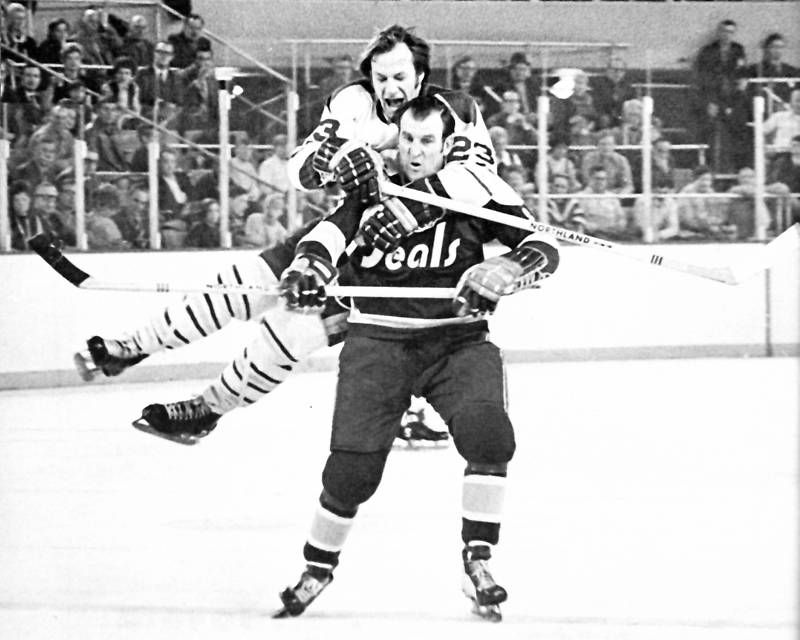
Who does that, you might wonder? Well, Eddie did.
Shack scored 25 goals in his last big offensive season with the Penguins before the Leafs brought him back for a second tour of duty in the summer of 1973. By then there was not much pretense of us winning a Cup or anything so hopeful (the Leafs had had an awful year in 1972-’73, missing the playoffs), but when he played, Eddie was still Eddie— capable of electrifying the home crowd, upsetting the opposition, making an old school Shack-like rush up the ice, and scoring the odd goal.
Most hockey fans know of Eddie’s “back story.” Born and raised in Sudbury, family circumstances meant there was no opportunity for a formal education. He had to work at a very young age. He revealed somewhere along the way that he was not taught to read and write at an early age. But this was a young man who went on to work his tail off to chase his dreams.
He had a gift for hockey that took him eventually to southern Ontario and the aforementioned junior team in Guelph. He turned his hockey gift into much more: He was an entertainer on the ice and became as well know off the ice as he was on. He became a popular and effective spokesperson for companies when relatively few hockey stars (even some great ones of the era) were able to parlay their hockey popularity into off-ice “success.”
He was a popular after-dinner speaker at banquets. He was a family guy, an entrepreneur, and very much self-made. He worked for what he achieved—and he achieved a lot.
He was “Eddie the Entertainer” and “The Clown Prince of Hockey,” the guy broadcaster Brian McFarlane wrote a song about (“Clear the track, here comes Shack…”).
While I’ve been fortunate to at least meet or even interview a number of great old-time Leafs over the years (Bower, Andy Bathgate, Jim Dorey, and Bobby Nevin, to name a few) I never had the opportunity to meet or interview Eddie Shack. But I’ve long had the sense that there was more to the man than “just” being a hockey player who could entertain us — much more than simply being a shrewd businessman who knew how to “make a buck” off his name.
Others who knew him well could speak to this much better than I, for sure. But I know this: At a time in my life when hockey (outside of my family) was just about the most important thing in my young life more than 60 years ago, Eddie Shack was part of a group of men that I followed intently—game after game, season after season.
Some seasons ended in heartbreak. Others ended with that feeling that only a fan who really and truly “cares” can experience when their team has done something special.
Shack was part of those four Leaf Cup teams in the 1960s, and he finished his NHL career in the mid-1970s where he belonged: in Toronto. Where he was loved. Where he was appreciated. Where he was respected for being even more than a really good hockey player and a really good Maple Leaf.
He brought joy to people’s lives. By all accounts, his public face was forever happy. He was of good heart and good spirit. Hockey was a part of his life, but only a part.
When someone has died, we talk often nowadays of someone having lived a “good life.” By all accounts, Eddie Shack most certainly did.
Thank you for the memories, Eddie. And rest easy. You deserve it.


![Jim Montgomery Post Game, Bruins 4 vs. Leafs 2: “[Marchand] still manages to get under people’s skin, yet he doesn’t cross the line” Jim Montgomery, Boston Bruins post game](https://mapleleafshotstove.com/wp-content/uploads/2024/04/jim-monty-pg-to-218x150.jpg)
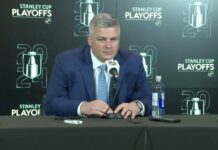





















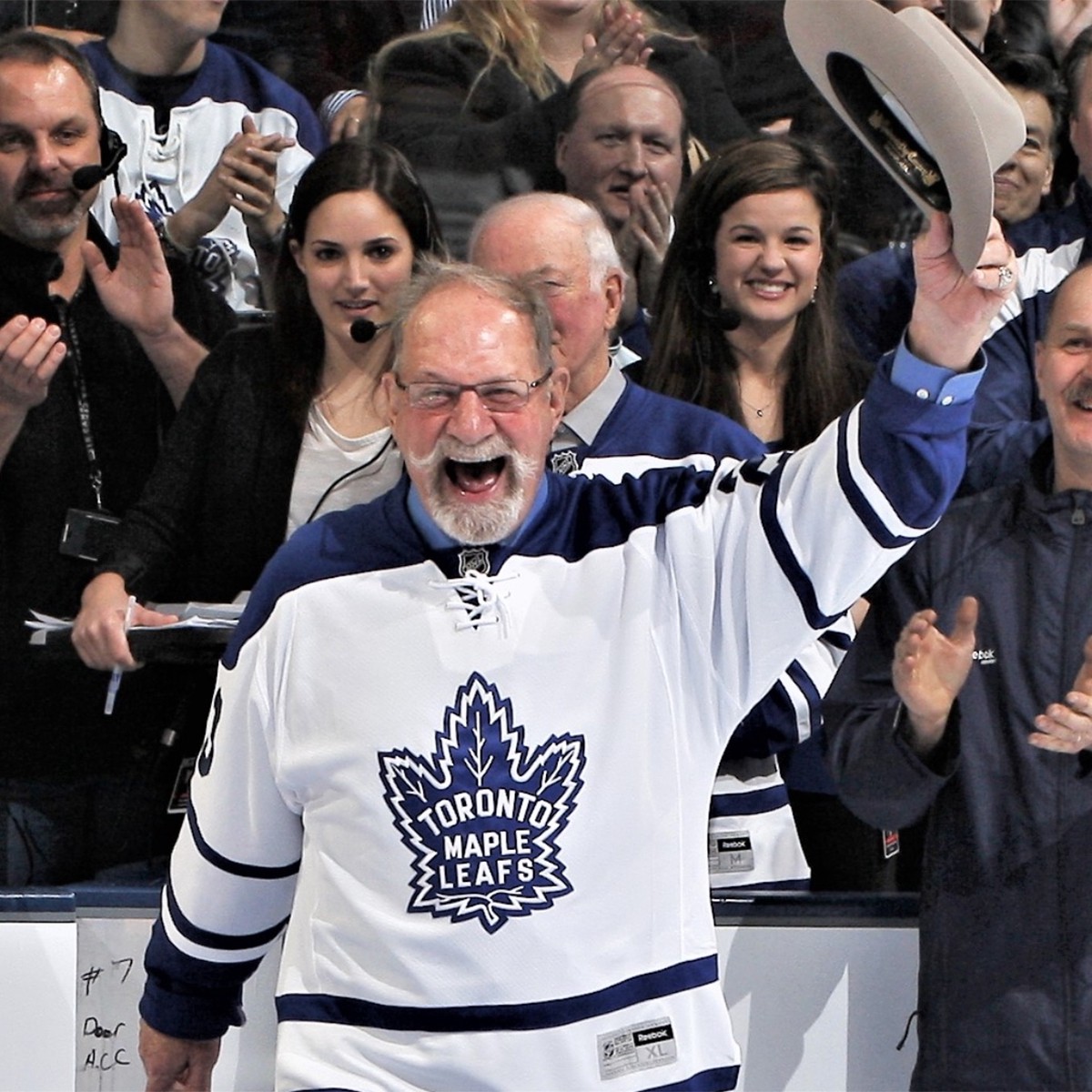
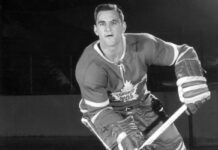
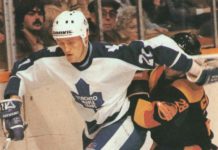
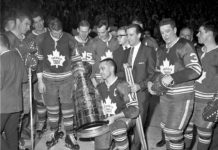

![Jim Montgomery Post Game, Bruins 4 vs. Leafs 2: “[Marchand] still manages to get under people’s skin, yet he doesn’t cross the line” Jim Montgomery, Boston Bruins post game](https://mapleleafshotstove.com/wp-content/uploads/2024/04/jim-monty-pg-to-100x70.jpg)







